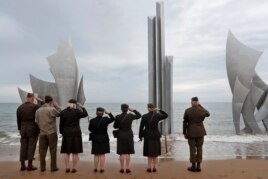05 June, 2019
D-Day was the largest invasion the world has ever seen. Tens of thousands of Allied troops spread out across the air and sea along northern France. Their goal was to gain control of Normandy for the final military campaign against Nazi Germany.
Books and films about D-Day often show an all-white group of soldiers arriving in Normandy on June 6, 1944. Among them, about 2,000 African Americans are believed to have landed at the time.
The African Americans served in a United States military that separated people by race. But on Normandy, everyone faced the same dangers.
The only African American force in battle that day was the 320th Barrage Balloon Battalion. Its job was to set up explosive-rigged balloons to prevent German airplanes from attacking the Allies.
Waverly Woodson, Junior, was a medical worker with the battalion. Before his death in 2005, he told The Associated Press in 1994 about how his landing ship hit a mine on the way to Omaha Beach.
"The tide brought us in, and that's when the 88s hit us," he said of the German 88 millimeter guns. "They were murder. Of our 26 Navy personnel there was only one left. They raked the whole top of the ship and killed all the crew. Then they started with the mortar shells."
Woodson himself was wounded, but he spent 30 hours on the Normandy coast helping other wounded men before eventually collapsing. A U.S. senator is now leading an effort to award the Medal of Honor to Woodson for his actions on D-Day. However, a 1973 fire destroyed the military personnel records needed to document the actions.
Another member of the African-American unit, William Dabney, told The AP in 2009, "The firing was furious on the beach. I was picking up dead bodies and I was looking at the mines blowing up soldiers. ... I didn't know if I was going to make it or not." Dabney died in 2018.

Enthusiasts of England salute in front of The Brave, a monument dedicated to the American soldiers who landed on Omaha Beach on D-Day, in Saint-Laurent-sur-Mer, Tuesday, June 4, 2019, in Normandy.
Linda Hervieux wrote about the 320th Barrage Balloon Battalion in her book "Forgotten: The Untold Story of D-Day's Black Heroes, at Home and at War."
Hervieux said the U.S. military resisted efforts to end racial separation policies as it prepared for World War II. The military kept separate units and separate areas for black and white troops.
"This was a very expensive and inefficient way to run an army. The Army ... could have ordered its men to integrate and to treat black soldiers as fully equal partners in this war. The Army declined to do so," she said.
By the end of the war, more than a million African Americans served in the military. They included the famed Tuskegee Airmen and the 761st Tank Battalion. Black troops, however, were often put in support units responsible for transporting supplies. That did not mean they were safe from danger.
Johnnie Jones joined the military in 1943 out of Southern University in Baton Rouge, Louisiana. He was in a unit responsible for unloading equipment and supplies onto Normandy. Now 99 years old, Jones remembers coming under German fire and returning fire alongside other soldiers during the landing.
After the end of the war in Europe, many African American troops were met with discrimination when they returned home. Jones remembers having to move to the back of a bus as it crossed the Mason-Dixon line. The line represented the border between the free states in the North from the slave-owning states in the South before the Civil War.
"I couldn't sit with the soldiers I had been on the battlefield with. I had to go to the back of the bus," said Jones, who went on to become a lawyer and civil rights activist. "Those are the things that come back and haunt you."
I'm Kelly Jean Kelly.
Rebecca Santana reported this story for the Associated Press. Hai Do adapted her report for VOA Learning English. George Grow was the editor.
Write to us in the Comments Section or on 51VOA.COM.
_______________________________________________________________
Words in This Story
rig - v. to put something (explosive) secretly in (a place)
rake - v. to shoot many bullets
furious - adj. very angry
expensive - adj. costing a lot of money
decline - v. to say that you will not or cannot